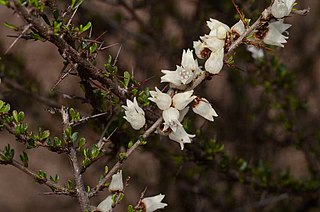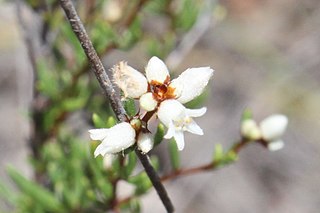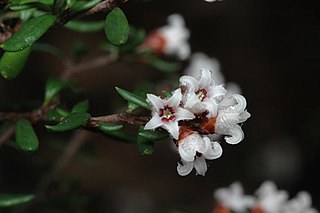Triplarina calophylla is a species of flowering plant in the myrtle family, Myrtaceae and is endemic to a restricted area of north Queensland. It is a shrub with egg-shaped leaves with the narrower end towards the base, flowers with five sepals, five white petals and fourteen or fifteen stamens.

Triplarina volcanica is a species of flowering plant in the myrtle family, Myrtaceae and is endemic to Queensland, where it is only found in three mountainous areas. It is a shrub with elliptical to egg-shaped leaves with the narrower end towards the base and flowers with five sepals, five white petals and fourteen to sixteen stamens.

Cryptandra armata is a flowering plant in the family Rhamnaceae and is endemic to Queensland. It is a shrub with spiny branchlets, spatula-shaped to lance-shaped or egg-shaped leaves with the narrower end towards the base, and creamy-white tube-shaped to bell-shaped flowers.
Cryptandra ciliata is a species of flowering plant in the family Rhamnaceae and is endemic to south-eastern Queensland. It is a shrub with clustered linear leaves and densely-hairy, white, tube-shaped flowers.

Cryptandra debilis is a species of flowering plant in the family Rhamnaceae and is endemic to north Queensland. It is a small shrub with clustered, linear leaves and densely-hairy, white, tube-shaped flowers.
Cryptandra distigma is a flowering plant in the family Rhamnaceae and is endemic to inland Western Australia. It is a shrub with oblong or narrowly egg-shaped leaves and clusters of white to cream-coloured, tube-shaped flowers.
Cryptandra filiformis is a species of flowering plant in the family Rhamnaceae and is endemic to north Queensland. It is a shrub with narrowly elliptic to narrowly lance-shaped leaves and white to creamy-white, tube-shaped flowers.
Cryptandra gemmata is a species of flowering plant in the family Rhamnaceae and is endemic to the far north of the Northern Territory. It is a shrub with clustered linear leaves and white to creamy-white, tube-shaped flowers.
Stenanthemum argenteum is a species of flowering plant in the family Rhamnaceae and is endemic to a restricted part of Queensland. It is a shrub with hairy branches, lance-shaped to egg-shaped leaves with the narrower end towards the base, and heads of about seven hairy white, tube-shaped flowers.
Cryptandra graniticola is a flowering plant in the family Rhamnaceae and is endemic to southern Western Australia. It is an upright, spreading shrub with spiny branchlets, linear to narrowly egg-shaped leaves and clusters of white, tube-shaped flowers.
Pimelea fugiens is a species of flowering plant in the family Thymelaeaceae and is endemic to central Queensland. It is a shrub with elliptic leaves and heads of 12 to 18 pale yellow, tube-shaped flowers.

Cryptandra lanosiflora is a species of flowering plant in the family Rhamnaceae and is endemic to eastern Australia. It is a shrub with many branches, linear leaves, and hairy, white tube-shaped flowers.

Cryptandra longistaminea is a species of flowering plant in the family Rhamnaceae and is endemic to eastern Australia. It is a shrub with many branches, egg-shaped or elliptic to linear leaves, and clusters of white, tube-shaped flowers.
Cryptandra pendula is a flowering plant in the family Rhamnaceae and is endemic to the southwest of Western Australia. It is a shrub with linear leaves and clusters of 5 to 15 pendulous, white, tube-shaped flowers.
Cryptandra pogonoloba is a species of flowering plant in the family Rhamnaceae and is endemic to south-eastern Queensland. It is a shrub with linear to lance-shaped leaves with the narrower end towards the base, and white to creamy-white, tube-shaped flowers.

Cryptandra propinqua is a species of flowering plant in the family Rhamnaceae and is endemic to south-eastern continental Australia. It is a shrub with many branches, more or less linear leaves, and spike-like clusters of white, tube-shaped flowers.
Stenanthemum tridentatum is a species of flowering plant in the family Rhamnaceae and is endemic to the southwest of Western Australia. It is a prostrate to upright shrub with sparsely hairy young stems, egg-shaped to fan-shaped leaves, and creamy white or creamy-yellow flowers arranged singly or in groups of up to three.
Pimelea mollis is a species of flowering plant in the family Thymelaeaceae and is endemic to southern Queensland. It is a shrub with hairy young stems, elliptic leaves and heads of 24 to 45 white, tube-shaped flowers.
Cryptandra triplex is a species of flowering plant in the family Rhamnaceae and is endemic to the north of the Northern Territory. It is a hairy shrub with narrowly elliptic to lance-shaped or egg-shaped leaves and white to cream-coloured or yellowish, tube-shaped flowers arranged singly or in groups of up to 5 in leaf axils, near the ends of branches.
Micromyrtus gracilis is a species of flowering plant in the myrtle family, Myrtaceae and is endemic to central Queensland. It is a slender shrub with overlapping, egg-shaped leaves and white flowers arranged singly in leaf axils with 5 stamens in each flower.






